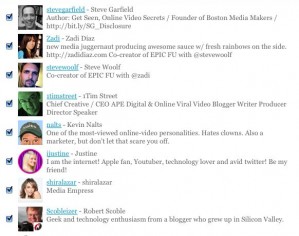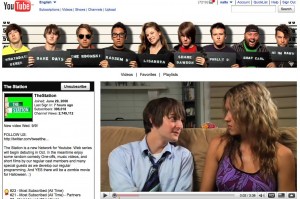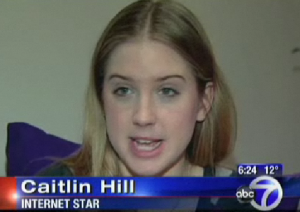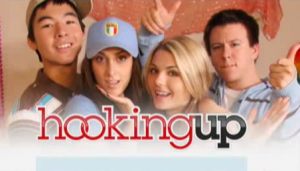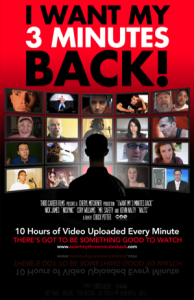As you regular readers know, this WillVideoForFood blog is designed for three audiences:
- online-video creators who aspire to generate income from their work,
- marketers, public relations firms and advertisers looking to access the most visceral form of social media: online video (in a way that’s neither a “viral video gamble” or as uncontrollable as “consumer generated advertising),
- and, of course, you loyal WVFF tribe members that are the most vocal in comments.
I’m excited to announce a new company that can connect the first two groups, but let me first acknowledge that I’m not an objective journalist when I write about Hitviews. I’m also a “Hitviews Star” (shut up, I like the title) and I’m consulting with the NYC company. Here’s the release that announces the official launch of Hitviews. If you find any typos, you can blame me.
Caitlin Hill (aka TheHill88 on Hitviews) was tapped last year by broadcast veteran Walter Sabo to build a bridge between marketers and online-video stars (who aspire to actually, God forbid, make money from their creative talents and don’t aspire to become actors). Caitlin has been quietly recruiting a number of prominent online-video “stars” who, in effect, are like mini TV networks. They have large, recurring audiences that rival many prime-time television shows. You know who some of these “stars” are (a few are on YouTube’s “most subscribed” list), but their anonymity is being respected. Not everyone is as brave as Uncle Nalts to admit they want to monetize their work, and this is still oddly stigmatized in the inner circles of YouTube and other social networks. Due to my complete lack of talent, I was not on Hill’s radar until fairly recently… but I was aware that she had flown some top video creators to NYC from around the globe, and was sufficiently jealous.
As Sabo likes to say, “every new medium creates new stars.” Lucille Ball was a b-list actor until television. Nathan Lane can sellout broadway shows, but has a list of several failed sitcoms. Some super stars translate from television and film, but the evolution of media (from silent films to online-video) has proven that each era opens doors to new talent. Sabo and his investors are betting that marketing dollars will flow toward these new online-video stars, many of whom lack agents (or if they do have have agents they’re scrambling for acting gigs in traditional media, where most online-stars will go to die).
Until now, these “star” video creators have derived income from ad-sharing invented by Revver, then Metacafe, and now exists via YouTube as the “partners program.” While we online-video creators can disclose our Revver and Metacafe earnings (which are virtually nothing for me anymore), YouTube Partners are prohibited by contract from disclosing YouTube earnings. But it’s no secret that only a select number of amateur video creators have been able to quit their day jobs yet (sxephil, mrsafety and whatthebuck being notable exceptions). Yet many of my friends are making more via YouTube than I made in my first job after business school.
Meanwhile, brands have had only two options for promoting via online video (and I recognize that I’m over simplifying this):
- They can buy display ads surrounding videos (these are extremely cost efficient, but aren’t extremely profitable to YouTube or creators for that very reason). Studies have and will prove that these ads drive awareness and attributes at a decent price, but smart advertisers will want to go beyond pre-rolls, InVideo and display ads.
- Alternatively, brands like Mentos and other clients I’ve sponsored have done one-off deals with individual creators (sometimes directly, and often via an internet agency). This is where Uncle Nalts makes the majority of his video money, but certainly not enough to quit the day job. Naturally these indivudualized deals provide brands with higher impact, but are not easy to execute. A notable example is TayZonday doing “Cherry Chocolate Rain” for Diet Dr. Pepper Cherry Chocolate (as a Diet Dr. Pepper fan, I must confess the first 12-pack I bought was also my last). Other sponsored online-video deals are less transparent, and I don’t care for that as a creator or a viewer. I’ve never taken money from a sponsor who wasn’t thanked and acknowledged. And I don’t like the looming question about whether LisaNova was paid or not for the video I watched. Is she entertaining or persuading me? Again- most people don’t care that my Reader’s Digest dog and cat costume video was sponsored as long as the video is satisfying, but as a marketer, creator and avid viewer… I like when it’s clear.
A few startups have attempted to broker the complex relationship between hungry advertisers and hungry video creators. And while no model is perfect, Hitviews’ model is the best I’ve seen. It’s quite different from Xlntads (now Poptent) because it’s not about finding amateurs and video directors who can produce online-video content for use on television or online.
The Hitviews model is to introduce advertisers into the context of already popular video “shows,” videos or “channels.” This takes the form of sponsored videos, product placement or other offerings. The offline analogy I like to use is Oprah…. I can’t remember the last advertiser I saw drop a 30-second spot during Oprah, but won’t soon forget when she gave away Pontiacs to her viewing audience. And whether she’s paid or not, she can create a best selling book by simply mentioning it. In the same way, a popular online-video star can give brands access to their loyal and often sizable audiences. The web stars don’t yet have Oprah-sized audiences, but the top YouTube creators, as an example, have as many daily viewers as a prime-time show. And because they interact with their audiences, they’re as influential or more.
When I began writing about this space almost 3 years ago, I would have predicted there would be several Hitviews-like companies by now. But it’s a tricky market, and hard to enter even when it’s not your sole focus; brands have to be convinced that their audiences are moving online and that they don’t need to create their own content to engage them (do we need a Vlastic Pickle video portal?).
Brands will always buy ads, of course, but we’ll see a shift in 2009 away from $250K “viral videos” projects that fail to deliver view counts to justify them. They’ll give way to more creative programs leveraging popular video creators that a) already have recurring audiences, b) know how to promote with transparency but not perceived as “selling out,” c) can create videos that are promotional but more importantly entertaining, and c) are comfortable with providing advertisers with a final approval of their work (that latter criteria is not trivial).
It’s an important service that requires a delicately balancing four stakeholders: The “stars,” the sponsors, the audiences, and the investors. But the financial potential is promising for the simple reason that a brand’s investment and risk is relatively low, and the impact is far higher than a preroll, InVideo ad or banner. And the “stars” have booming audiences but lack the costs and complexities of traditional broadcasting.



